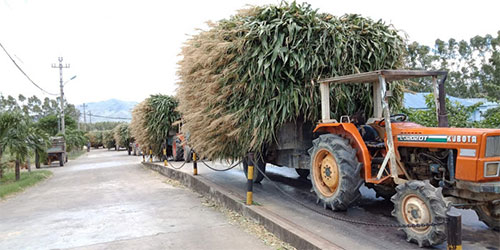Corn Silage made in Vietnam
In the course of Agritechnica Asia, international "Expert Talks" on crop-specific topics were held daily last week. Rice production in Myanmar, sugar cane cultivation in Thailand, but also silage production in Vietnam.
To this end, DLG invited Mr. Gonen Harel. He is the Director of Husbandry and Veterinary of the Vietnam Dairy Products Joint Stock Company, Vinamilk. Among other things, he is responsible for providing sufficient feed to approximately 7,000 cows. The herd is divided into smaller units of 1,000 - 1,200 animals. Feeding is based 100% on silage, which is also the standard in Vietnam for the large farms.
The company does not have its own forage growing areas and cooperates with small farmers from the region for the supply of corn for silage. And this is where the story starts to get interesting. For about 1,200 animals, 261 small farmers supply the corn. This is harvested by hand on the small plots, each plant individually. The harvest is loaded onto transport trucks and driven by tractor over the company scales to the farm area.
Dumped there, an army of workers stands ready to feed the corn, again by hand, into a small forage harvester, which is located in a large-scale silo. A job that promises neither quality nor efficiency. Different corn types, moisture and qualities coupled with long lay times and insufficient chopping quality. These deficiencies in the process chain ultimately have an impact on the performance of the herd.
However, since Mr. Harel took over the position, there have already been some changes in the right direction. His influence is only beginning to take hold where the corn is at the farm. Together with local engineers, he developed the Roto Grind Technology, a kind of standing corn chopper with a rotating hopper that can be filled by front loader - one is reminded of a feed mixer. The chopping capacity is higher and more uniform.
Afterwards, it is stored in the silo. Gonen Harel regularly has the many employees send him cell phone photos of how the work is progressing to ensure that compaction and chopping quality are working reasonably well. He also advocates the use of better cover film, which was previously only very thin and did not provide sufficient air seal. In addition, the technology for extracting the silage out of the silo for feeding is being further developed. Regular forage samples are taken in order to improve the quality of the process and ultimately the quality of the forage.
There is always potential for optimization, but at the same time Vinamilk sees itself as one of the largest employer of small farmers in the region and cannot lightly abandon this social responsibility by establishing its own large areas and large-scale technology. The key here is to maintain a balance.
You can listen to and watch this and other "Expert Talks" by registering once at www.agritechnica-asia.com/digital-connect.

